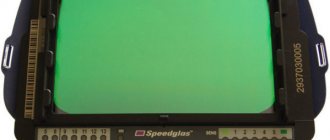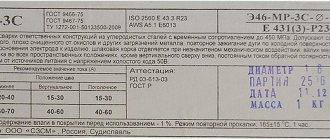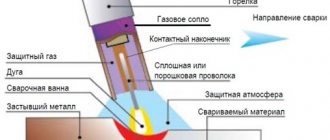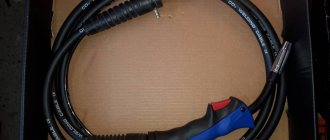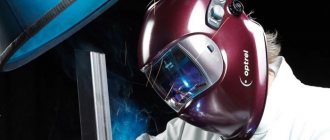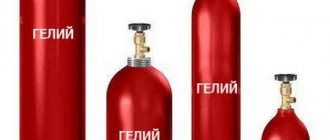The principle of electric arc welding is based on the use of the temperature of the electrical discharge that occurs between the welding electrode and the metal workpiece.
An arc discharge is formed due to electrical breakdown of the air gap. When this phenomenon occurs, gas molecules are ionized, its temperature and electrical conductivity increase, and it transitions to the plasma state.
The burning of a welding arc is accompanied by the release of a large amount of light and especially thermal energy, as a result of which the temperature rises sharply and local melting of the workpiece metal occurs. This is welding.
What it is?
A welding arc is an energetic electric charge between the electrodes, which has a long duration and a large amount of energy released; it is characterized by a potential difference that occurs in a gas environment. The definition of this concept also indicates that a metal with a high electrical voltage density heats up at a high rate, initially becoming plastic, and subsequently ready for melting.
The maximum temperature that an electric arc can reach is considered to be no more than 7000 degrees Celsius. In practice, in welding it is known that metals that have the inherent property of melting at a temperature of more than 3000 degrees are processed in this way. According to theoretical data on the properties and structure of this electric charge, it has the form of a conductor based on ionized gas. It consists of parts, zones , which release a large amount of thermal energy when current flows through them.
When the arc is ignited, a galvanic circuit is created . A pair of electrodes takes part in this process, which is a combination of an anode, cathode, and ionized gas. When current flows, it causes heating and glowing. The latter is due to photon radiation.
When constructing welding circuits, one cannot do without the participation of the following areas:
- anodic;
- cathode;
- arc column, which has a length of 4 to 6 millimeters.
In the first areas, active spots appear, and maximum voltage drop and heating occur. During the action of an electric arc, not only increased temperature is observed, but also ultraviolet radiation.
Ultraviolet radiation negatively affects the eyes and outer skin of a person. For this reason, welders during the procedure are required to use protective equipment, for example: masks, mittens, clothing made of thick fabric, shoes made of non-flammable material.
Thanks to the current-voltage characteristic, the power of the arc voltage is determined, which is directly connected to the power source. Many other factors, such as its length, depend on the power of the welding arc. Characterized by the same parameters of electricity sources, an arc with a longer length will have higher power.
The welding arc is used in the standard welding process, and it is characterized by the simplicity of the procedure. In addition, this energetic electric charge has found its application in semi-automatic gas welding. In this case, a welding wire is fed into the arc, which helps melt the material.
Arcs are also used in automatic machines, which are considered quite simple to create and are therefore common in industrial production. In this case, both fusible and non-fusible electrodes can be used. Manual arc welding works with ordinary structural steel, while it ensures combustion stability and reliability of the seams.
The power of welding arcs is directly dependent on the following factors:
- the length of the welding electric arc - it is also capable of determining the amount of heat that is released during combustion;
- current strength - high current strength prevents the extinction of a long arc;
- voltage – as the voltage increases within a small range, the power increases.
The current-voltage characteristic of an energy electric charge is a graph that expresses the dependence of voltage on a change in current. This indicator can have the following types:
- downward, which decreases as voltage increases;
- stable, which does not change when the current strength changes;
- ascending, increasing with increasing current, it is usually used in automatic welders.
Compared to other electric charges, the arc is characterized by the following features:
- high current density;
- uneven voltage drop along the discharge column;
- inverse proportionality of temperature relative to its thickness;
- a large number of operating mode options.
Electric welding can be called the fastest and most reliable option for permanently connecting parts of a metal structure. It can be used in a wide variety of areas of human life , from construction to transport.
Welding arc structure: cathode spot, arc column, anode spot
The cathode spot is the source and exit point for electrons. This section of the electric arc is heated to a temperature of 2400-2600°C when using coated electrodes, and the amount of heat generated in this section is 38% of the total. In this section of the arc, 12-17 V of voltage is lost, concentrated on the acceleration of the electrodes and their emission.
The arc column, in contrast to the cathode and anode spots, is a neutral section of the arc, where an equal number of positively and negatively charged particles are simultaneously located. The arc column emits approximately 20% of the total heat. The voltage loss in this section of the welding arc depends on its length and is 2-12 V. The highest temperature of the arc column is 6000-8000°C.
The anode spot is the point where the electrodes enter the welding circuit from the arc. The temperature is 2400-2600°C, and the amount of heat generated is 42% of the total. The voltage drop is 2-11 V. The anode spot under the influence of constant bombardment has a concave shape, which is called a crater.
When welding with direct current, a distinction is made between direct and reverse polarity. Change polarity depending on the type of material being welded. If greater heating of the metal and depth of penetration are required, it is necessary to install the anode on the product, where more heat will be generated - straight polarity. When welding with reverse polarity, the anode and cathode are swapped, so less heat is generated on the product.
AC arc welding typically reverses polarity at a frequency of 50 Hz, so the same amount of heat is generated at the electrode and the workpiece. When welding with alternating current, the arc burns less persistently and the spattering of the electrode metal increases.
AC Welding
Everything described above concerned the procedure for welding with direct current. However, alternating current can also be used for these purposes. As for the negative aspects, there is a noticeable deterioration in stability, as well as frequent jumps in the combustion temperature of the welding arc. One of the advantages is that you can use simpler, and therefore cheaper equipment. In addition, in the presence of a variable component, such an effect as magnetic blast practically disappears. The last difference is that there is no need to select polarity, since with alternating current the change occurs automatically with a frequency of about 50 times per second.
It can be added that when using manual equipment, in addition to the high temperature of the welding arc with the manual arc method, infrared and ultraviolet waves will be emitted. In this case, they are emitted by a discharge. This requires maximum protection for the worker.
Types of welding arc
The welding arc and its characteristics may differ in the direct and indirect action of the welding current, as well as in the atmosphere in which they are formed. Let's look at this topic in more detail. The direct action of the welding arc is characterized by a special direction of the current. The electrode is positioned almost parallel to the surface to be welded and the arc is formed at an angle of 90 degrees. The electric welding arc and its characteristics can also be of indirect action. It can only be formed using two electrodes located at an angle above the surface of the part being welded. Here a welding arc also occurs and the metal melts. As we wrote above, welding arcs are also divided according to the atmosphere in which they are formed. Here is their brief classification:
- Open environment. In an open environment (atmosphere), an arc is formed by oxygen from the air. A gas is formed around it, containing vapors of the metal being welded, the selected electrode and its coating. This is the most common medium used in arc welding.
- Closed environment. In a closed environment, the arc burns under a thick layer of protective flux and a gas is also formed, but containing not only metal and electrode vapors, but also flux vapors.
- Gas environment. The arc is ignited and one of the types of compressed gas is supplied (it can be helium or hydrogen). An additional supply of compressed gas also protects the parts being welded from oxidation; the gases form a neutral environment. Here, as in other cases, a gas is formed, which contains vapors of the metal, electrode and compressed gas, which the welder additionally supplies during the burning of the arc.
Welding arcs can also be stationary or pulsed. Stationary ones are used for long, painstaking work without the need to frequently move the arc. And pulse is used for fast one-time work.
Also, the welding arc and its characteristics can be indirectly classified according to the type of electrode used in the work (for example, carbon or tungsten, consumable and non-consumable). Experienced welders most often use a non-consumable electrode to better control the quality of the resulting welded joint. As you can see, the welding process with a simple welding arc can have many features, and they need to be taken into account in your work.
Application area
The welding arc is used in manual electric arc welding, which has become a reliable assistant for professionals and home craftsmen. Manual welding uses fusible electrodes coated with a flux compound. During the welding process, the rod material melts, forming the weld material, and the coating, when burned, releases a cloud of gases that protect the weld pool from exposure to oxygen. Manual welding is used both when working with conventional unalloyed structural steels and in unique welding operations on stainless, high-alloy alloys and non-ferrous metals.
The same arc is used in semi-automatic installations. Instead of an electrode, they use a welding wire fed by a mechanical device at a constant speed. Inert gases are pumped into the working area through the burner nozzle. This technology is characterized by optimal consumption of welding materials and high stability of weld parameters. Due to the high cost of the equipment, it is cost-effective for large volumes of welding work.
Automatic welding is carried out in special hermetically sealed volumes filled with inert gas. It is used for welding work with non-ferrous metals and especially critical operations with stainless alloys.
The influence of temperature on the metal welding process
Low temperatures do have an impact on the welding process. The molten metal cools and crystallizes at a faster rate. This means that all dissolved gases do not have time to escape from the weld pool or non-metallic inclusions enter the slag. This situation can lead to the formation of cracks or pores in the seams. The following statistics are known: when the temperature decreases from +20 °C to -50 °C, the residence time of the weld pool in the liquid state decreases by 10%. This, in turn, leads to the fact that half of all detected defects relate specifically to non-metallic inclusions.
At low temperatures, heat removal from the welding zone increases. This impairs the penetration of the edges of the joined elements and can lead to the formation of another serious defect - lack of fusion. An additional danger comes from moisture condensation on the electrodes or metal. Water is a source of hydrogen, which promotes the formation of pores in joints. In addition, at low temperatures the ductility of steels and the mechanical properties of welds deteriorate.
All the above facts are true, but they are fully manifested at extremely low temperatures (from -40 ° C and below). Household welding rarely requires work in such difficult conditions. As a rule, we are talking about a temperature not lower than -10 °C. Additionally, it should be taken into account that carbon steels are most often used for domestic purposes. If the thickness of the elements being connected is no more than 16 mm, you can work with them in the usual manner down to a temperature of -30 °C. For low-alloy steels, this figure for the same thickness is slightly lower and amounts to -15 °C.
The lowest temperature is maintained in outer space. It is -273 °C, but even in such conditions it is possible to carry out welding work. They were first carried out in 1984 by Soviet cosmonauts S. Savitskaya and V. Dzhanibekov. For this purpose, a specially created electron beam welding apparatus was used.
The nature of the phenomenon
The arc formation process is as follows:
- The welder touches the metal workpiece with the electrode for a split second.
- At the moment of contact, a short circuit occurs, accompanied by the flow of high current and, as a consequence, a powerful release of heat.
- The metal melts at the point of contact. It becomes viscous and viscous.
- At the moment the consumable is separated from the workpiece, a drop of melt trails behind it.
- Lengthening, it becomes thinner with the formation of the so-called. cervix. At some point, it evaporates and turns into a cloud of charged particles. At the same time, due to the high temperature in this zone, the air or shielding gas is ionized.
- Under the influence of an electric field, negative charge carriers rush to the anode, positive charge carriers - to the cathode. The process of current flow in the plasma begins.
At the moment of contact, a short circuit occurs and the metal at the point of contact melts. Each stage lasts milliseconds, the discharge occurs almost instantly. The current is then maintained by the emission of electrons at the cathode. On their way to the anode, they ionize gas and metal vapor, increasing the number of free charge carriers.
Modern welding machines are equipped with a high-frequency vibration generator (oscillator). This device allows you to excite the arc in a non-contact manner.
Combustion conditions
Under normal conditions, at normal pressure and temperature of 20 ° C, gases, and above all air, are not conductors. In order for them to conduct electricity, special conditions must be created: a large number of ions must be released from atomic orbits. This process is called ionization.
The work required to release one electron is called the ionization potential. For various materials it ranges from 3.5 to 20 electron volts. The lowest potential is typical for alkaline elements: potassium, calcium and their compounds. These substances are added to the electrode coating or welding wire in order to maintain stable discharge parameters. They are also added to the composition of flux powder for closed type welding.
To ensure high quality welded joints, it is necessary to maintain stable electric arc parameters, such as current, voltage, and temperature.
Temperature is determined by the following factors:
- Cathode material.
- Cathode dimensions.
- Environmental conditions.
Arc temperature distribution
The constancy of the current parameters - voltage and strength - is ensured by the current source. A large number of designs of such sources have been developed for welding work - from outdated bulky welding transformers and rectifiers to modern inverters and semi-automatic machines.
Power supplies
When welding, only those ignition methods and stabilizers that can satisfy the following requirements should be used:
- light the arc with ease;
- stably maintain the combustion process;
- monitor the upper threshold of short circuit current;
- have good dynamics;
- be characterized by electrical safety.
Welding arc power sources have the following classification:
- purpose - sources are divided into those that are suitable for manual welding, flux welding or in a gas-protected environment;
- the number of welding stations that can be connected at one time;
- possibility of movement, namely: mobile and stationary;
- energy production: producer and converter;
- type of output current;
- volt-ampere characteristics.
Current sources:
- the transformer is a simple welding unit with a reactive inductor at the base;
- a rectifier is a device that straightens electric current;
- converter - a device using mechanical action to convert alternating current into direct current;
- inverter - this welding machine is considered the most suitable for fulfilling household needs; these mobile devices are characterized by compactness and ease of use.
To produce a high-quality and reliable weld, you will need to create an electric arc. To use this type of energy electric charge, you do not need any special skills. However, the welder must know the peculiarities of the occurrence, use and formation of the welding arc.
How is the power of a welding arc determined?
The power parameters of the electric arc are influenced by several factors:
How to use cold welding correctly
To obtain a good seam, careful execution of the following steps is of utmost importance:
Technological process of cold welding
- Clean the bonded surfaces from oil, fat and mechanical contaminants. Cleaning can be mechanical (abrasives, steel brush), chemical (solvents and degreasers) and combined.
- All actions are carried out only in protective gloves.
- Squeeze the two-component composition out of the tubes and mix the components well.
- Separate the required amount of plasticine-shaped composition from the block with a spatula and carefully close the remaining block.
- Knead the composition. It should heat up slightly, maintaining plasticity; once the required consistency is achieved, apply the mixture to the surfaces to be glued.
- Securely press the surfaces together by wrapping the parts with an elastic band.
- If pipes are being repaired, the composition must be applied with several smoothing movements.
- After the time specified in the technical specifications as the initial drying time (90% of the glue sets), the tourniquet can be removed.
- The repaired product can only be used after the final hardening time has passed, usually 24 hours.
It is better to remove the remaining adhesive with a spatula after applying and applying the tourniquet. If they have already hardened, they can be removed by lightly tapping them with a hammer.
Volt-ampere characteristics
The current-voltage characteristic describes the dependence of current parameters. Using this graph determine:
- arc power;
- burning time,
- extinction conditions.
Dynamic current-voltage characteristic describes the unsteady state of an electric arc when its length fluctuates. The static current-voltage characteristic reflects the dependence of voltage on amperage at a constant arc length. The graph is divided into three areas:
- falling - as the current increases, the voltage drops sharply, this is due to the formation of a column: the cross-sectional area of the plasma flow increases, the electrical conductivity of the plasma changes;
- hard, this is a section of stable current density and voltage drop, with an increase in amperage from 100 to 1000 A, the diameter of the arc column increases proportionally (the anode and cathode spots change, respectively);
- increasing, characterized by a constant size of the cathode spot, it is limited by the diameter of the electrode; with increasing amperage, according to Ohm's law, U, R of the arc column increases.
Static current-voltage characteristics of the welding arc: 1 - falling;
2 - hard; 3 - increasing. The current-voltage characteristic of the process of conventional manual welding using consumable and non-consumable electrodes in air or in a cloud of shielding gas is limited to the first two areas; the amperage does not reach the third. Mechanized welding using fluxes corresponds to the schedule of regions II and III, welding with a consumable electrode in a cloud of a protective atmosphere - III.
When using equipment that generates alternating current, the welding arc is excited in each half-cycle, at the ignition peak. When crossing zero, the electric arc dies out and heating of the active spots stops. Electrode coatings containing active alkali metals increase the stability of ionization. The protective cloud makes it difficult to ignite on alternating current, but maintains combustion on constant current. Between the poles, ionization of gas molecules occurs.
When choosing equipment, it is necessary to take into account that the current-voltage characteristic of the electric arc depends on the external current-voltage characteristic. The operation of the welding machine is considered as an overlay of schedules. For manual welding, power sources with falling regions of the current-voltage characteristic (increased open-circuit voltage) are required to be able to change the arc length by adjusting the amperage. The strength of the short circuit current during the fall of a drop from the consumable electrode onto the metal being welded is 20–50% higher than the arc current. For consumable electrode welding, a trip arc is used. To ignite an arc with a tungsten or carbon electrode, an auxiliary discharge is desirable.
At high values of short circuit current, the risk of metal burns increases. When a drop falls, a short circuit occurs, then sharply increases to its original values - the amperage increases to the value of the short circuit current, the resulting bridge burns out, and the arc is excited again. Changes in current and voltage in the column occur instantly, in a fraction of a second. Welding equipment must quickly respond to fluctuations and stabilize the voltage.
For direct and reverse polarity
DC welding can be performed in 1 of 2 ways:
- “Plus” is connected to the workpiece, i.e. it becomes the anode. This polarity is called straight.
- A minus is connected to the workpiece, so that it becomes the cathode. This is reverse polarity.
DC welding can be done in a variety of ways.
When welding with a refractory electrode, the anode spot is hotter than the cathode spot, so the first method is used to join parts of medium or large thickness. Strong heating ensures deep penetration and, as a result, high strength of the seam.
Reverse polarity connection is used to connect thin-walled workpieces. Otherwise they will burn out.
When welding with a consumable electrode, the anode spot is colder, so they do the opposite.
How to adjust arc length
Not only electrical quantities, but also the quality of welding depend on this parameter. They strive to make the arc as short as possible, within 3-4 mm.
With a longer length, the following negative phenomena are observed:
- Drops of molten metal from the electrode on the way to the weld pool manage to absorb a lot of oxygen and nitrogen from the air. As a result, the seam loses strength, ductility and toughness.
- The discharge moves along the surface of the workpiece (wandering), as a result of which the heat is distributed over a relatively large area. The penetration depth decreases; drops of melt from the consumable, falling on unheated metal, do not merge with it, but bounce off.
A short arc produces a dry crackling sound, reminiscent of oil sizzling in a hot frying pan.
With a long welding arc, negative phenomena are observed.
The seam she made looks neat and has the following characteristics:
- Correct form.
- Smooth convex surface.
The seam, made with a long arc, has uneven outlines, and drops of molten metal stick along it.
Welding principle
As mentioned above, the principle of fusion welding is based on the process of mixing molten metal in the welding zone, forming a strong, permanent joint. The thermal energy source, which has a fairly large power, concentrates thermal energy on a small area of the weld pool. It is in this bath that the alloy brought to the melting point is located, which is fed there either using an electrode or with a special wire (in the case of welding with a fireproof electrode). By moving the source of thermal energy along the edge of the parts being joined, the weld pool is also moved, gradually adding filler material to it. After cooling, the bath material crystallizes, which leads to the formation of a strong weld.
The process of igniting a high-temperature arc consists of three sequential steps. First, the electrode touches the workpiece, resulting in a short circuit that causes the tip to heat up. Next, the tip is moved a short distance from the part; this distance is selected experimentally. It should be such that the arc is most stable. Heating the electrode is necessary for stable exo-emission of electrons, which also guarantees a stable electric arc.
Fusion welding principle
When the electrode melts, the filler material is transferred into the weld pool, and the parts are joined. On some welding machines designed for welding with a fireproof electrode, arc ignition is non-contact. It is performed by a special device called an oscillator.
About arc welding modes
The joining of parts by fusion is carried out under various conditions. A set of measures, indicators and parameters designed to ensure good quality of the weld in any situation is called the welding mode.
The parameters characterizing it are divided into 2 groups:
- basic;
- additional.
The first include:
- electrode diameter;
- current strength;
- arc voltage.
The joining of parts by fusion is carried out under various conditions. Extra options:
- position of the seam in space;
- speed of work;
- composition and thickness of the metal.
The current strength is determined by the properties of the welding machine and is indicated in the instructions for it. The amount of heat generated, and therefore the depth of penetration, depends on it. Thick-walled elements of large metal structures exposed to heavy loads are connected with increased current. On the contrary, it can burn through a thin part, so the amperage is reduced.
The diameter of the electrode must correspond to the current strength.
Otherwise, the following negative points arise:
- Reduced diameter. The coating on the rod is damaged and the arc becomes unstable.
- Oversized diameter. The current density decreases, the length of the arc and its position become unstable, the seam becomes uneven and fragile.
Parameters of manual welding modes are given in the table:
| Thickness of welded parts, mm | 0,5 | 1-2 | 3 | 4-5 | 6-8 | 9-12 | 13-15 | 16 |
| Electrode diameter, mm | 1 | 1,5-2 | 3 | 3-4 | 4 | 4-5 | 5 | 6-8 |
| Current strength, A | 10-20 | 30-45 | 65-100 | 100-160 | 120-200 | 150-200 | 160-250 | 200-350 |
Regardless of the thickness of the workpieces, seams on vertical surfaces and ceilings are made with an electrode with a diameter of 4 mm.
Powerful connections are made in several approaches:
- Boil the root of the seam using a rod with a diameter of 3-4 mm.
- Apply the required amount of surfacing using thicker products.
Powerful connections are made in several approaches.
As the speed of the process increases, the width of the seam decreases, and vice versa. This parameter should be kept within reasonable limits. If the speed is too high, the metal does not have time to completely melt, and uncooked areas form in the joint. When welding slowly, the steel spreads, which also negatively affects the quality of the seam. The width of the connection and the depth of penetration depend on the trajectory of the electrode. It is moved in a straight line, zigzag, herringbone, etc.
Characteristics and composition of cold welding
The main characteristics of cold welding are:
- Presence and composition of filler.
- The initial drying time is the so-called time. “setting”, during this time the composition must be applied to the gluing area and leveled.
- Final curing time - the product cannot be used before this period.
- Application temperature - the recommended temperature at which the mixture can be applied to the surface.
- Maximum operating temperature.
The plastic cold seal adhesive composition can consist of one or two components. Its required components are:
- The adhesive base is in the form of epoxy resin, which determines the plastic properties.
- The filler is metal powder, evenly distributed throughout the volume.
- Quality improving additives, such as sulfur.
The quality of a weld obtained by cold welding depends on conditions such as:
- Quality of adhesive material.
- Preparing the surfaces of parts for gluing.
- Compliance with technology.
The strength of the resulting seam in real conditions will be lower than that of a seam produced by the hot method.
Therefore, the technology is best applicable for local repairs of lightly loaded products.
Welding machines "Arc"
The reliability of the connection depends on the following equipment features:
- build quality;
- built-in electronics;
- equipment used.
A good machine is expensive, but a cheap one does not allow you to get a neat and durable seam. Equipment of the Duga brand is free from both disadvantages. It has an affordable price, but only due to the simplification of the design, and not the loss of quality. The manufacturer did not equip the devices with an expensive inverter. He took a transformer product as a basis and made a number of improvements, calling the end result a “welding rectifier.” The result is an easy-to-use medium-power unit designed for household work on direct current.
The most popular 2 models are:
- 318MA;
- 318M1.
The first is characterized as follows:
- Welding current – up to 160 A.
- Electrode type – consumable or tungsten with supply of argon and other protective gases.
- Power supply – from 220 V mains or generator.
The “Duga 318M1” model is positioned as semi-professional.
Its parameters:
- Welding current – up to 300 A with step adjustment.
- A variety of consumables are meltable with a coating, with a diameter of up to 6 mm.
- Power supply – 220 V network (plugged into an outlet).
- Cooling is forced.
The following types of work can be performed:
- Welding of stainless steel parts.
- Metal cutting.
- Surfacing.
The disadvantage of the "Duga" devices is their large dimensions and weight (50 kg).
Arc Features
The welding arc and its characteristics have a number of features that need to be taken into account in your work:
- As we have said many times, the arc has a very high temperature. It is achieved due to the high density of electric current (density can reach thousands of amperes per square centimeter). For this reason, it is important to set up the machine correctly and be careful when welding thin metals.
- The electric field is unevenly distributed between the electrodes if two of them are used. At the same time, the voltage in the welding column practically does not change, but in the cathode region this voltage decreases noticeably, which can lead to deterioration in the quality of the weld.
- In the welding column, in turn, the highest temperature is observed, which cannot be said about other parts of the arc. Keep in mind that if you need to increase the arc length, you will likely lose some of that temperature. This indicator is especially important when welding metals with a high melting point.
You can also adjust the voltage drop of the welding arc by selecting the current density. The higher the current density, the more likely it is that the welding arc voltage will drop. But there are cases when the voltage of the welding arc increases due to increasing current. To control this process you will need some experience. Don't be afraid to experiment if your job allows you. These were the main properties of the welding arc that you should pay attention to.
Arc protection
Examples of protective suits against electric arc
If welding machines use an arc, then many other machines and in addition a person should avoid it. The risk of arcing on equipment depends on several factors:
- frequency of use of the equipment by the employee;
- experience and knowledge of workers dealing with hardware
- equipment wear level;
If a person is not wearing the necessary personal protective suit and falls into the area of effect of the electric arc, the chances of survival decrease quite sharply. The risk of severe burns is extremely high.
Table
Table: degree of exposure to electric arc
What are the possibilities for protection from email? Dougie?
- comply with all necessary safety rules and regulations;
- in case of prolonged use of protective material, frequent washing, the suit should not deteriorate; (it all depends on the model);
- the fabric must have a maximum of 2 seconds of residual combustion;
- you must wear special shoes that have an antistatic effect and also have a suit for protection against electric arcs .
Things to know
The ultraviolet component of arc radiation is extremely dangerous to the eyes and skin, so welders use a protective suit and mask with tinted glass. Glare reflected from walls can also cause retinal burns, accompanied by severe pain.
The arc voltage in manual welding is low.
The arc voltage during manual welding is small - from 15 to 30 V. But during the process of replacing consumables, it increases to 70 V and can cause an electric shock. Special care is required from the welder.
When working with a machine, the risk of electrical injury is significantly lower.
